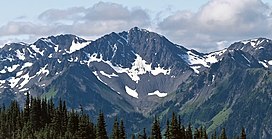| McCartney Peak | |
|---|---|
 North aspect North aspect | |
| Highest point | |
| Elevation | 6,784 ft (2,068 m) |
| Prominence | 544 ft (166 m) |
| Parent peak | Mount Cameron (7,190 ft) |
| Isolation | 2.71 mi (4.36 km) |
| Coordinates | 47°51′15″N 123°23′13″W / 47.8542120°N 123.3869141°W / 47.8542120; -123.3869141 |
| Geography | |
  | |
| Country | United States |
| State | Washington |
| County | Jefferson |
| Protected area | Olympic National Park |
| Parent range | Olympic Mountains |
| Topo map | USGS McCartney Peak |
| Geology | |
| Rock age | Eocene |
| Climbing | |
| Easiest route | class 2 scrambling |
McCartney Peak is a 6,784-foot-elevation (2,068-meter) mountain summit located within Olympic National Park in Jefferson County of Washington state. Part of the Olympic Mountains, McCartney Peak is situated 18 miles south of Port Angeles, and set within the Daniel J. Evans Wilderness. Topographic relief is significant as the southwest aspect rises 3,800 feet (1,200 meters) above the Lost River in approximately 1.5 mile. Precipitation runoff from the mountain drains north into headwaters of the Lillian River, east to the Gray Wolf River via Cameron Creek, and west to the Elwha River via Lost River. The nearest higher neighbor is line parent Mount Cameron, 3.1 mi (5.0 km) to the southeast.
History
McCartney Peak was in the late 19th century known as "Lillian Peak," and nearby Windfall Peak was originally named McCartney Peak, for a trapper known as "Old Man McCartney" who frequented this area. Over the subsequent years, mapping errors resulted in present-day names and locations.
Climate
Based on the Köppen climate classification, McCartney Peak is located in the marine west coast climate zone of western North America. Weather fronts originating in the Pacific Ocean travel northeast toward the Olympic Mountains. As fronts approach, they are forced upward by the peaks (orographic lift), causing them to drop their moisture in the form of rain or snow. As a result, the Olympics experience high precipitation, especially during the winter months in the form of snowfall. Because of maritime influence, snow tends to be wet and heavy, resulting in avalanche danger. During winter months weather is usually cloudy, but due to high pressure systems over the Pacific Ocean that intensify during summer months, there is often little or no cloud cover during the summer. The months July through September offer the most favorable weather for viewing or climbing this mountain.
Geology
The Olympic Mountains are composed of obducted clastic wedge material and oceanic crust, primarily Eocene sandstone, turbidite, and basaltic oceanic crust. The mountains were sculpted during the Pleistocene era by erosion and glaciers advancing and retreating multiple times.
See also
References
- ^ McCartney Peak, climbersguideolympics.com
- Olympic Mountain Rescue, Olympic Mountains: A Climbing Guide, 4th Edition, 2006, Mountaineers Books, ISBN 9780898862065, page 158.
- ^ "McCartney Peak - 6,784' WA". listsofjohn.com. Retrieved January 2, 2022.
- "McCartney Peak". Geographic Names Information System. United States Geological Survey, United States Department of the Interior. Retrieved January 2, 2022.
- Parratt, Smitty (1984). Gods and Goblins: A Field Guide to Place Names of Olympic National Park (1st ed.).
- Peel, M. C.; Finlayson, B. L.; McMahon, T. A. (2007). "Updated world map of the Köppen−Geiger climate classification". Hydrol. Earth Syst. Sci. 11: 1633–1644. ISSN 1027-5606.
- ^ McNulty, Tim (2009). Olympic National Park: A Natural History. Seattle, Washington: University of Washington Press.
- Alt, D.D.; Hyndman, D.W. (1984). Roadside Geology of Washington. pp. 249–259. ISBN 0-87842-160-2.
External links
- "Olympic National Park". National Park Service.
- Weather forecast: McCartney Peak
- McCartney Peak: Mountain-forecast.com
| Places adjacent to McCartney Peak | ||||||||||||||||
|---|---|---|---|---|---|---|---|---|---|---|---|---|---|---|---|---|
| ||||||||||||||||